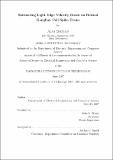Estimating light edge velocity based on retinal ganglion cell spike trains
Author(s)
Eisenman, Adam
DownloadFull printable version (6.370Mb)
Other Contributors
Massachusetts Institute of Technology. Dept. of Electrical Engineering and Computer Science.
Advisor
John L. Wyatt.
Terms of use
Metadata
Show full item recordAbstract
This thesis is intended to present a specific sub-problem of a larger one we call the 'Inverse Problem'. We wish to estimate the velocity (speed and direction) of an edge of light which is moving on the photoreceptor layer of a rabbit retinal patch. We make these estimates based solely on the electrical response measured from the retinal ganglion cells (RGCs). We present various algorithms for doing so and present sensitivity analysis of such algorithms. We test the performance of the algorithms on data recorded from retina and on data produced by simulation. We find that we are able to extract enough information about the edge velocity from ON and OFF RGCs when the edge of light is wide. However, our best algorithm's performance decays significantly as the edge of light gets narrower. This leads us to develop algorithms that use ON-OFF directionally selective (DS) cells in conjunction with non-directional ON and OFF cells to produce better estimates of the velocity for narrow edges of light. In addition, we develop a model to simulate the response of a DS cell to 1-dimensional light motion.
Description
Thesis (S.M.)--Massachusetts Institute of Technology, Dept. of Electrical Engineering and Computer Science, 2007. This electronic version was submitted by the student author. The certified thesis is available in the Institute Archives and Special Collections. Includes bibliographical references (p. 136-137).
Date issued
2007Department
Massachusetts Institute of Technology. Department of Electrical Engineering and Computer SciencePublisher
Massachusetts Institute of Technology
Keywords
Electrical Engineering and Computer Science.